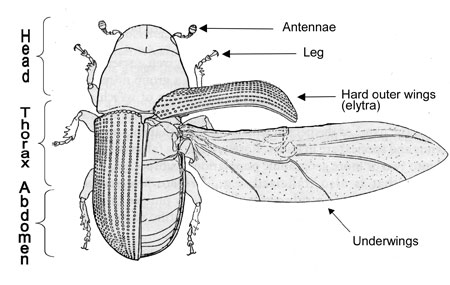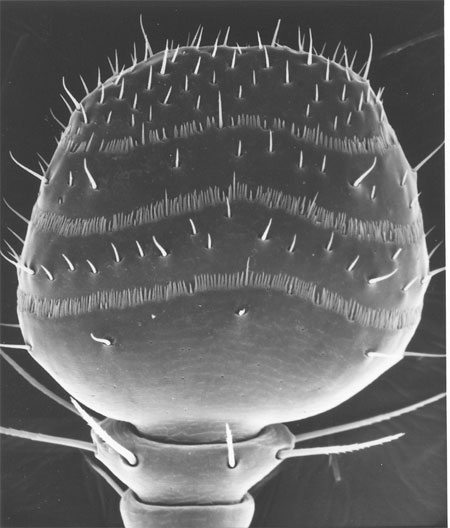Beetle anatomy
 |
Through compound eyes: A closer look at mountain pine beetle
The relationship between mountain pine beetle and their host pine trees has been evolving for hundreds of years. The anatomy of the beetle reflects this relationship with adaptations designed specifically for penetrating the bark and phloem of the host tree.
In general, bark beetles have a hard exoskeleton, a three-region body (head, thorax, and abdomen), two compound eyes, three pairs of jointed legs, and two antennae. The legs and wings are attached to the thorax. The front pair of hardened wings forms the “elytra” which protect the hind wings. Mountain pine beetle are small, dull (not shiny), cylindrical, and have elbowed, club-like antennae. The following is a detailed description of mountain pine beetle anatomy.
What’s in a name?
They are over 300 000 known beetle species on the planet. They make up over 40% of all known species of insects! To keep track of all the organisms on earth, scientists have developed a classification system where each is given a Latin name that tells us something about the species. The Latin name for mountain pine beetle is Dendroctonus ponderosae Hopkins. “Dendroctonus” means “tree-killer, and “ponderosae” refers to “pine tree.” When a non-italicized name appears after the Latin name (like Hopkins) it usually refers to the person who discovered and named the species.Many Latin names in the classification system describe anatomical features that separate one group of animals from another. Mountain pine beetle is a part of these larger groups in the classification system, and their names provide information about their bodies:
Kingdom: Animalia, meaning all living or extinct animals
Phylum: Arthropoda, meaning “jointed limbs”
Class: Insecta – meaning “incised.” This refers to the fact that insects generally have a sharp division between the head and thorax and between the thorax and abdomen.
Order: Coleoptera – includes all beetles – and means “sheath wings” – referring to the hardened forewings or “elytra” that cover the membranous – see through – hind wings
 Mountain Pine Beetle Anatomy. Mountain Pine Beetle Anatomy.© Diagram modeled after Hopkins 1909. Interpreted by Malcolm Furniss and labelled by Niki Wilson. |
The exoskeleton
Beetles don’t have bones and an internal skeleton like we do. They have an exoskeleton that is like a large shell. It protects them and gives them shape. Tiny hairs called “setae” on the outside of the exoskeleton help improve the beetle’s perception of touch and sound.Region 1: The head
Unlike the thorax and abdomen, the head is not segmented. Found on the head are the eyes, antennae and the mouthparts. Inside the head is the “brain” that is made up of “ganglia” which are clusters of nerve cells. From the brain a double nerve cord runs back along the bottom of the body and coordinates activities like feeding and flying.
Eyes
Beetles have “compound eyes.” Each eye is made up of many units called “ommatidia”. There can be thousands of ommatidia in a single beetle eye. Through the ommatidia, beetles see in patterns of light and dark dots. Much like the resolution of an image on our computer, the number and size of the dots (or ommatidia) affect how well the beetle can see. In some ways, seeing through a beetle eye is like looking through a kaleidoscope: there are many images instead of just one. The compound eye is excellent at detecting motion. As an object moves across the visual field, ommatidia are turned on and off in response. As a result of this "flicker effect", insects respond far better to moving objects than stationary ones. Despite all of these ommatidia, beetles can’t see as effectively as humans, and must also rely on other senses to move around.
Antennae
Each mountain pine beetle has a set of antennae on its head. Antennae are very important to beetles, as they provide constant information about touch, smell and taste. Beetles use taste and smell receptors on their antennae to locate food and also to identify pheromones.
 All bark beetles are characterized by antennae that are enlarged at the end. This structure contains receptors (the pointed projections) which detect odors of tree resin and mates, thus it functions as the beetle's nose. Illustrated is the antenna of the red turpentine beetle, which infests the base of many pine species. All bark beetles are characterized by antennae that are enlarged at the end. This structure contains receptors (the pointed projections) which detect odors of tree resin and mates, thus it functions as the beetle's nose. Illustrated is the antenna of the red turpentine beetle, which infests the base of many pine species.© Malcolm Furniss |
Mouthparts
Mountain pine beetle need strong mouthparts to be able to chew through bark and phloem. Their mouthparts move in a cutting motion like scissors.
Region 2: The thorax
The thorax is the middle body region – between the head and the abdomen – that serves as an attachment point for the legs and wings. This is where the heart is located which pumps blood toward the front of the body. Blood does not circulate through vessels, but passes freely between and around body organs. The thorax itself is composed of 3 segments, with a pair of legs located on each segment and 2 pairs of wings found on the second and third segment. The thorax is where the muscles are located that help the beetle walk, jump and fly.
Legs
Adult beetles have 6 legs. Each of the segments of the thorax bears 1 pair of legs. The legs are jointed, and the last segment of the leg bears a small claw.
When beetles walk, a foreleg and hind leg on one side and a middle leg on the other are always touching the ground. This creates a “tripod” on which the beetle balances, and on the next step the beetle alternates to the other three legs to form a new tripod. Walking from tripod to tripod is called “hexapody.”
Wings
The mountain pine beetle has two pairs of wings found on the second and third segment of the thorax. One pair is the hard-shelled outer wings called the “elytra”. These are not used for flying, but to protect the beetle’s flying set of wings and its body as it crawls through narrow passages and tunnels in a tree. The second set of wings is membranous or see-through, and is folded under the elytra when not in use.
Region 3: The abdomen
The abdomen is the posterior or last of the three body regions in the mountain pine beetle. It is the biggest body part and is composed of 11 segments. The abdomen holds the beetle's digestive system and reproductive organs, and is also where beetles breathe! Beetles don’t have lungs like mammals do – instead they breathe through a series of holes in their abdomens called “spiracles.” Air passes directly into the abdomen through the spiracles and circulates through the body by a system of branching tubes.
Related links
- Date modified :